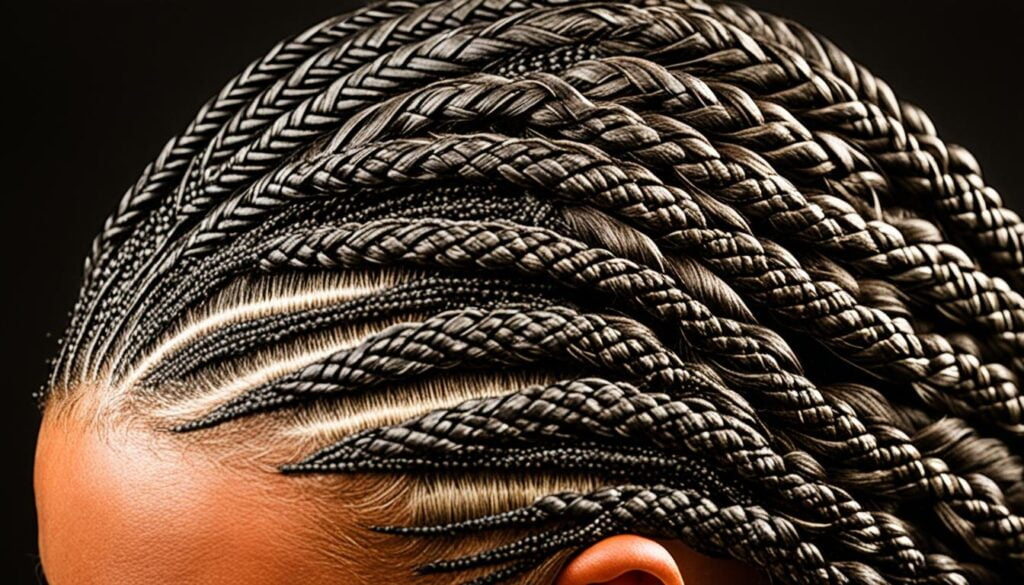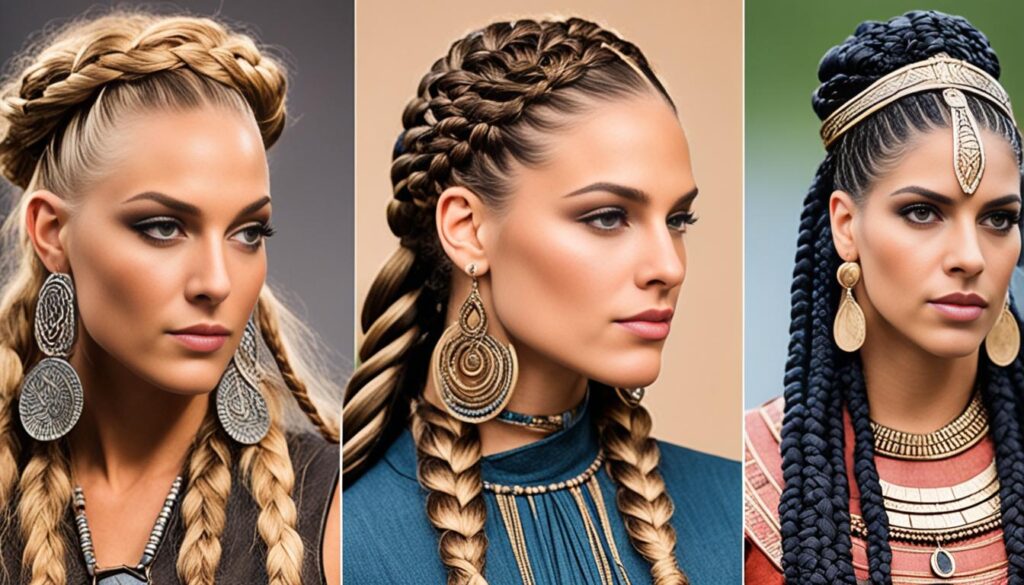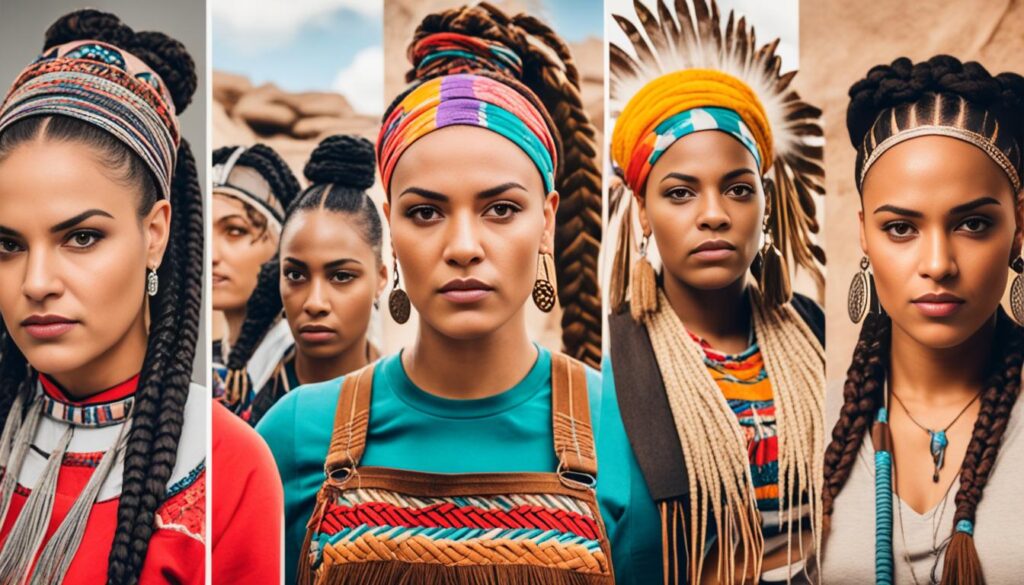
Braids have been a staple hairstyle throughout history, but have you ever wondered which culture first embraced this unique and timeless look? The history of braids dates back thousands of years, and the origins of braided hairstyles may surprise you. Explore the fascinating journey of braids and discover the culture that wore them first.
Key Takeaways:
- The history of braids dates back to 3500 BC.
- The Himba people of Namibia were one of the earliest adopters of braided hairstyles.
- Braids have been used in African tribes to signify social status, ethnicity, religion, and more.
- Braiding techniques and styles have been influenced by various cultures such as Egypt, Greece, Native Americans, Europe, China, and the Caribbean.
- Cornrows, box braids, and other braided styles have gained popularity in different time periods.
The Origins of Braids in African Culture
Braids have deep roots in African culture, with the Himba people of Namibia being one of the earliest cultures to embrace braided hairstyles. For the Himba people, braids were more than just a fashion statement; they were a means of identification and self-expression.
In African tribes, different braid patterns and styles carried specific meanings, representing a person’s tribe, age, marital status, wealth, power, and even religion. Braids served as a distinctive visual language, allowing individuals to communicate their identity within their community.
This intricate social art of braiding created strong bonds between generations. Elders would pass down their knowledge and expertise to the younger members of the community, teaching them the braiding techniques and the cultural significance behind each style. As a result, braiding became a cherished tradition, upheld and celebrated over generations.
Over time, the practice of braiding spread beyond African culture, captivating people from different backgrounds around the world. Braided hairstyles gained popularity across various cultures, with each region adding its own interpretation and style to this ancient tradition.
The Himba People of Namibia
Examples of Braided Hairstyles in African Culture
| Braid Style | Meaning |
|---|---|
| Cornrows | Symbolized unity and strength within the community |
| Fulani Braids | Represented femininity and cultural heritage |
| Box Braids | Signified versatility and individuality |
| Twists | Symbolized growth and wisdom |
It’s fascinating to see how the Himba people of Namibia played a crucial role in the origin and evolution of braided hairstyles. Their rich cultural heritage continues to inspire and influence the diverse styles we see today.
Braids in Ancient Civilizations
Braids were not limited to African culture, but were also seen in ancient civilizations like Ancient Egypt, Greek and Roman cultures, and Native American cultures.
In Ancient Egypt, braids were not only a fashion statement but also a symbol of social status. Wealthy women would adorn their braids with gold and jewels to display their wealth and power.
In Greek and Roman cultures, both men and women wore braids for different purposes. Soldiers would wear braids to keep their hair out of their faces during battle, while women would style their hair in intricate braided patterns for special occasions.
Native American cultures also had their unique braiding techniques, with different tribes using braids as a way to communicate their tribal affiliation, family lineage, and individual achievements.
These ancient civilizations valued braids not only for their practicality but also for their cultural and symbolic significance.
| Ancient Civilization | Significance of Braids |
|---|---|
| Ancient Egypt | Braids as a symbol of social status and wealth |
| Greek and Roman cultures | Braids for practical purposes in battle and intricate styles for special occasions |
| Native American cultures | Braids used to communicate tribal affiliation, family lineage, and achievements |
Ancient Egypt
In Ancient Egypt, braided hairstyles were not only fashionable but also carried deep cultural significance. Wealthy women would adorn their braids with gold and jewels as a way to showcase their wealth and social status. These elaborate braided hairstyles were reserved for the upper class and were seen as a symbol of beauty and power.
Greek and Roman cultures
In Greek and Roman cultures, both men and women wore braids. Soldiers would often wear braids to keep their hair out of their faces during battle, ensuring better visibility and preventing distractions. On the other hand, women would style their hair in intricate braided patterns for special occasions, such as weddings and ceremonies. These braided hairstyles were admired for their elegance and sophistication.
Native American cultures
Native American cultures had their own unique braiding techniques and styles. Different tribes used braids as a way to communicate their tribal affiliation, family lineage, and individual achievements. Braided hairstyles were intricately woven and often decorated with beads, feathers, or other meaningful symbols. These braids represented cultural identity and were a source of pride for Native Americans.
Early Braiding Techniques and Styles
Early braiding techniques and styles have influenced the diverse range of braided hairstyles we see today. From traditional African braids to classic European styles, these braiding techniques have stood the test of time and continue to inspire modern hair trends. Let’s explore some of the most iconic braiding styles.
Cornrows

Cornrows are characterized by tight braids that are closely woven to the scalp. This braiding technique has been practiced in Africa for centuries and is deeply rooted in African culture. Cornrows gained significant popularity in North America during the 1970s, becoming a symbol of African heritage and Black pride.
Box Braids
Originating from Africa, box braids consist of small sections of hair that are braided and secured using synthetic or natural hair extensions. These braids gained widespread popularity in the United States during the 1990s and continue to be a go-to protective style for many. Box braids offer versatility and allow for various styling options.
French Braid
The French braid is a timeless and elegant style that originated in France in the 1800s. It involves weaving three strands of hair together, starting from the top of the head and progressing downward. French braids are known for their intricate and polished appearance and are a popular choice for both casual and formal occasions.
Fulani Braids
Fulani braids have been adorned by the Fulani people of West Africa for centuries. These braids are often adorned with beads, shells, or metal cuffs, adding a decorative element to the hairstyle. Fulani braids not only showcase cultural heritage but also serve as a form of self-expression and personal style.
Viking Braids
Viking braids, known for their intricate and interwoven patterns, originated in Scandinavia during the Viking Age. These braids were worn by both men and women as a symbol of strength, courage, and honor. In recent years, Viking braids have experienced a resurgence in popularity, finding their place in modern hairstyles and even pop culture.
These braiding techniques and styles have left a lasting impact on the world of hair fashion. They showcase the rich history, cultural diversity, and artistry of braided hairstyles. Whether you choose cornrows, box braids, French braids, Fulani braids, or Viking braids, each style holds its own unique significance and adds a touch of individuality to your look.
The Evolution of Braids
Braids have a rich history that spans across cultures and time periods. From ancient civilizations to modern times, braided hairstyles have remained popular and versatile. Let’s explore how braids have evolved throughout history, adapting to different cultural influences and societal trends.
Braids Throughout History
Braids have adorned the heads of people for centuries. From simple styles to intricate patterns, braids have been a constant presence in various cultures worldwide. In medieval Europe, braids were favored for their simplicity and practicality. In contrast, China and Japan developed more intricate braiding techniques that showcased their craftsmanship and attention to detail.
Braids In Different Cultures
Across different cultures, braids held cultural significance and symbolized various aspects of identity. In African cultures, braids were more than just a hairstyle. They represented social status, tribe affiliation, age, marital status, and religious beliefs. For example, the Fulani people in West Africa adorned their braids with beads and shells, while the Himba people of Namibia created unique braid patterns to identify themselves.
Moreover, braids were not limited to African cultures. Ancient Egyptians saw braids as a symbol of wealth and power, often embellishing their braids with gold and jewels. Greek and Roman cultures embraced braids as well, with soldiers wearing them for practical purposes and women styling intricate braided patterns for special occasions.
Braids In Modern Times
During the Victorian era, braids regained popularity, largely influenced by Queen Victoria’s iconic braided hairstyles. However, in the early 20th century, braids fell out of fashion in Western cultures while remaining prevalent in other parts of the world, particularly Africa. Braids resurged in the 1970s when they became a symbol of cultural pride and empowerment.
Today, braids are more popular than ever, with people from all walks of life embracing different braid styles. Celebrities often sport braids on red carpets and in music videos, setting trends and inspiring millions. From elegant updos to bohemian braids, there is a multitude of options to express personal style and creativity.
Braids in Modern Culture
The enduring popularity of braids in modern society can be attributed to their versatility, timelessness, and ability to transcend cultural boundaries. Braids have become a symbol of self-expression, allowing individuals to showcase their unique identity and style. Additionally, social media platforms have played a significant role in popularizing and promoting braided hairstyles, with influencers and beauty enthusiasts sharing tutorials and inspiration.

Throughout history, braids have continuously adapted and evolved, remaining a staple in the world of hairstyling. Their cultural significance and versatility make them a cherished and celebrated aspect of our collective beauty traditions.
Cultural Significance and Appropriation of Braids
Braids have long been regarded as more than just a hairstyle. They represent cultural artifacts that hold deep historical roots, reflecting the identities, artistry, and social statuses of different cultures. However, the appropriation of braids as mere fashion trends without understanding or respecting their cultural significance has become a contentious issue.
The commodification of braids without acknowledging their origins has led to debates about cultural appropriation versus appreciation. It’s important to recognize and honor the cultural significance behind braids rather than reducing them to mere aesthetic choices. By appreciating braids as cultural artifacts, we can foster a deeper understanding and respect for the diverse traditions and histories they represent.
“Braids are an art form that represents our heritage, our ancestry, and our stories. They connect us to our roots and should be recognized for the cultural significance they hold.” – Jennifer Adams, Cultural Historian
To better understand the complexities surrounding cultural appropriation of braids, consider the following:
The Power of Representation
Braids are more than just a hairstyle; they are a means of self-expression and cultural pride. For many individuals, particularly in the Black community, braids are deeply tied to their heritage and history. By appropriating braids without acknowledging their origins, cultural significance, and historical contexts, we risk erasing the experiences and contributions of marginalized communities.
Fostering Cultural Appreciation
Appreciating braids as cultural artifacts involves educating ourselves about their origins, traditions, and cultural practices. It’s important to engage in respectful conversations and learn from diverse perspectives. By recognizing and celebrating the cultural significance of braids, we can foster a more inclusive and appreciative approach to cultural practices.
Addressing Appropriation
Recognizing cultural appropriation involves acknowledging the power dynamics at play and the potential harm caused when elements of a marginalized culture are co-opted without permission or understanding. Engaging in dialogue and actively addressing appropriation can contribute to creating a more equitable society.

Conclusion
Braids have withstood the test of time, continuing to showcase their enduring appeal and popularity. Their versatility and timeless beauty make braided hairstyles a favorite choice for individuals looking to express their personal style. Whether worn for practical reasons, cultural significance, or as a fashion statement, braids have remained a cherished aspect of hair styling.
From their origins in ancient civilizations to their evolution in modern society, braided hairstyles have adapted and transformed. They have served as a cultural symbol, a way to communicate social status, and a means of artistic expression. In different time periods and diverse cultures, braids have shown their enduring significance and allure.
Despite debates surrounding cultural appropriation, braids remain a beloved choice for many. Their enduring popularity is a testament to their unique ability to enhance beauty and create stunning looks. As we continue to celebrate the continuing popularity of braids and their enduring appeal, let us also appreciate and respect the cultural significance behind this timeless hairstyle.






